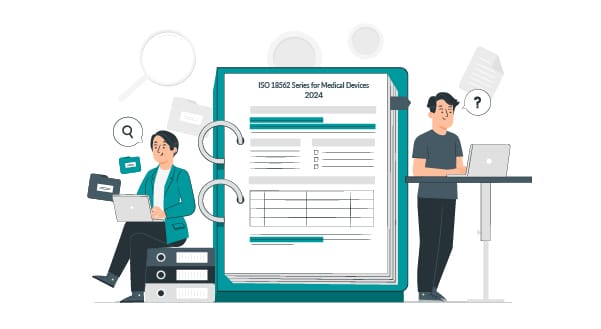Understanding the 2024 Updates to the ISO 18562 Series for Medical Devices

The ISO 18562 series of standards, which governs the biocompatibility evaluation of breathing gas pathways in healthcare applications, has undergone a significant revision in its 2024 edition. These updates introduce important changes that reflect advancements in testing methodologies, regulatory expectations, and the safety of medical devices. The U.S. FDA has already recognized the new standards, meaning these updates will apply to all new device submissions or updates moving forward. This whitepaper outlines the key changes and provides actionable insights for manufacturers navigating the updated requirements.
Key Objectives of the 2024 Revisions
The updates to the ISO 18562 series are designed to:
• Enhance the safety and biocompatibility assessment of materials and processes.
• Improve alignment with global regulatory requirements, including FDA standards.
• Incorporate state-of-the-art testing methods for more accurate and ethical evaluations.
• Streamline conformity assessments to simplify compliance for manufacturers.
Noteworthy Changes in the 2024 updates to the ISO 18562:2024 Series
The table below highlights the most significant updates:
Section
Risk Assessment Framework
Volatile Organic Compounds (VOCs)
Particulate Matter Testing
Chemical Characterization
Ethical Testing Alternatives
Post-Market Surveillance (PMS)
Key Updates
Expanded emphasis on risk-based approaches, requiring manufacturers to integrate assessments within their overall risk management systems.
More detailed requirements for identifying and quantifying VOC emissions from device materials.
Revised criteria for measuring particulate matter released into breathing gas pathways, with stricter thresholds.
Inclusion of additional guidance on assessing chemical leachables and extractables specific to breathing gas pathways.
Stronger alignment with ISO 10993-1 for biocompatibility testing, particularly for devices with multiple points of patient contact.
Introduction of validated in vitro methods to reduce reliance on animal testing.
Enhanced guidance on monitoring emissions and risks over the lifecycle of the device.
Section | Key Updates
Risk Assessment Framework
Expanded emphasis on risk-based approaches, requiring manufacturers to integrate assessments within their overall risk management systems.
Volatile Organic Compounds (VOCs)
More detailed requirements for identifying and quantifying VOC emissions from device materials.
Particulate Matter Testing
Revised criteria for measuring particulate matter released into breathing gas pathways, with stricter thresholds.
Chemical Characterization
Inclusion of additional guidance on assessing chemical leachables and extractables specific to breathing gas pathways.
Integration with ISO 10993
Stronger alignment with ISO 10993 for biocompatibility testing, particularly for devices with multiple points of patient contact.
Ethical Testing Alternatives
Introduction of validated in vitro methods to reduce reliance on animal testing.
Post-Market Surveillance (PMS)
Enhanced guidance on monitoring emissions and risks over the lifecycle of the device.
Harmonizing Testing for Global Compliance
Manufacturers looking to expand their markets or operate in the U.S. territory should consider harmonizing their testing to comply with both ISO 18562:2024 and FDA requirements. Harmonized testing not only ensures compliance across jurisdictions but also:
- Reduces Costs: By aligning testing methodologies, manufacturers can avoid duplication, saving significant costs in the long run.
- Extends Validation Lifespan: Cross-mapped validations can be used for multiple regulatory submissions, maximizing the value of each test.
- Simplifies Market Expansion: Harmonized data facilitates smoother submissions to both the FDA and other global regulatory bodies.
CLIN-r+ offers expert cross-mapping services to align ISO 18562 testing with FDA requirements. This ensures comprehensive compliance while optimizing resources.
💡 For more insights on FDA biocompatibility requirements, refer to these resources:
Implications for Manufacturers following 2024 Updates to the ISO 18562 Series for Medical Devices
The revisions in ISO 18562:2024 have direct implications for medical device manufacturers:
1. Regulatory Compliance
With the FDA’s recognition of the updated standards, manufacturers must incorporate these changes into new device submissions or updates to existing files. Failure to do so could result in delays or rejections during the regulatory review process.
2. Testing and Documentation
Manufacturers will need to update testing protocols, technical documentation, and risk management plans to align with the new requirements. This includes revisiting chemical characterization and VOC testing methodologies.
3. Resource Allocation
Adapting to these updates will require investments in training, updated equipment, and collaboration with specialized testing facilities. Early preparation will be key to minimizing disruptions.
4. Focus on Lifecycle Management
The new emphasis on PMS and lifecycle monitoring underscores the importance of long-term compliance strategies, even after initial approval.
How CLIN-r+ Can Help

Navigating the changes introduced by ISO 18562:2024 can be challenging, but CLIN-r+ offers expert support to ensure seamless compliance. Our services include:
- Gap Assessments: Identifying discrepancies between existing processes and the new standards.
- Testing Coordination: Working with accredited labs to meet updated testing requirements.
- Regulatory Strategy: Developing submission strategies aligned with FDA and global regulations.
- Cross-Mapping Services: Aligning testing to comply with multiple regulatory frameworks, saving costs and maximizing efficiency.
- Training and Education: Equipping your team with the knowledge to adapt to the new standards.
Conclusion
2024 Updates to the ISO 18562 Series for Medical Devices.
The 2024 edition of the ISO 18562 series represents a significant step forward in ensuring the safety and biocompatibility of medical devices with breathing gas pathways. By proactively understanding and implementing these changes, manufacturers can maintain compliance, enhance patient safety, and strengthen their market positioning.
For more information on how CLIN-r+ can support your transition to the updated ISO 18562:2024 standards, contact us today or schedule a consultation:
